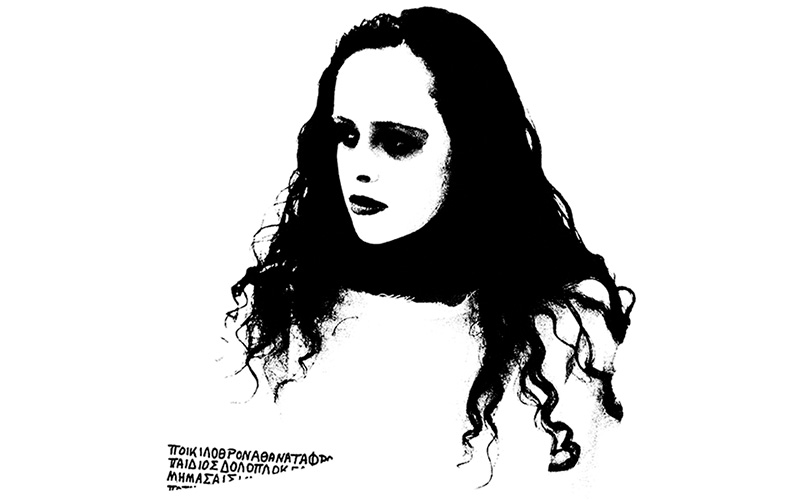
Sapphographs
Donovan
Hellenic American Union
June 1 – June 30, 2010
Introduction By
CHRIS MURRAY
Foreward By
GREGORY NAGY
Preface By
DONOVAN
Published on the occasion of Donovan’s Sapphographs exhibition at the Hellenic American Union, Athens, Greece. Organized in collaboration with the Center for Hellenic Studies, Washington, D.C., and Govinda Gallery, Washington, D.C.
This exhibition celebrates SapphoFest 2010.
Be Mine
Stars ‘round the fair moon veil their own shining
When She’s full on the earth with the light of Her silver
Set you to rest on the softest of cushions
The black trance of night on our eyes like the river
Be Mine from the album Sutras by Donovan.
Gathered from Sappho’s fragments.
Contents
Introduction
Foreword
Preface
The Sapphographs
Exhibition List
The Tenth Muse
Biographies
Acknowledgements
Colophon
5
6
8
9
21
22
23
25
26
Introduction
By Chris Murray
I have deeply appreciated and enjoyed the poetry and music of Donovan since he first emerged on the cultural scene in the 1960s. His creative energy has been an inspiration to me in many ways. It was my good fortune to meet Donovan in Washington, D.C. in 1967 after one of his extraordinary concert performances. My meeting Donovan was memorable for a number of reasons, not the least of which was he gave me a drawing he made that very day. I still have the drawing. Since that time of first meeting Donovan, my own work as a curator of exhibitions and editor and author of a number of books developed.
Though I consider myself as informed and as knowledgeable about Donovan’s artistry as anyone, I was very interested to learn not so long ago that Donovan counts Sappho and her poetry as one of his greatest inspirations. Sappho (7th century B.C.E.) is regarded as the pre-eminent lyric poet of ancient Greece.
One day while I was visiting Donovan and his wife Linda at their home in Ireland he showed me a series of visual images he had created that he aptly named ‘Sapphographs.’ I was intrigued and drawn to these beautiful works of art. They were based on a group of photographs that Donovan had taken, using as models for the pictures his muse and wife Linda, his daughter Oriole and her friend Lizzie. Also appearing in the Sapphographs are his daughter Astrella and grandson Sebastian. Donovan then utilized a number of techniques to transform the photographs into the series of works of art on paper that are depicted in this catalogue and are the subject of the exhibition at the Hellenic American Union in Athens.
Sappho has been represented and reinterpreted through many artistic mediums since her own time, over 2,500 years ago, up to today. Depicted by some of the greatest painters in museums throughout the world,
in illuminated manuscripts, by playwrights, in novels, in fashion, in ballet, and in popular music, Sappho has been updated in different times in different ways. Donovan’s Sapphographs are perhaps, the finest contemporary visual homage to Sappho. The lyrics poets of ancient Greece would sing their poems while accompanying themselves on stringed instruments. It is significant to note that in our own time, Donovan is considered to be one of our greatest lyric poets.
Inspired by the lyric poetry of Sappho, Donovan captures in visual form the mythic beauty of this ancient artistic tradition. Donovan’s Sapphographs evoke the aesthetic sensuality of nature and the power of its rituals to inspire artistic creation.
Foreword
By Gregory Nagy
I first saw the Sapphographs of Donovan in the early spring of the year 2007, on a balmy evening in the city of Washington. These images, inspired by Sappho’s luminous world of feminine loveliness, were on display in the Greek Embassy. A selection of Sapphographs lined the walls of an expansive space made somehow ethereal by the bright lighting. I was lost in my thoughts as I circled clockwise around the sequence of images, stopping at each Sapphograph and taking in the essence of each image. And each image brought to life for me a glimpse of loveliness. Following the sequence of glimpses was like hearing variations on a musical theme captured by the visual theme of each Sapphograph.
It made me think of the aptness of the modern world used for capturing the essence of each image, “Sapphograph,” combing the name of the ancient Greek world’s greatest female poet with the ancient Greek word graphein, the meaning of which touches on both the idea of writing and the more general idea of bringing something or someone to life by drawing, painting, even weaving.
It also made me think of variations on the theme of loveliness as sounded out in Song 1 of Sappho, where the goddess of loveliness herself, Aphrodite, is pictured as wearing a robe of woven patterns of blossoms. As the mind’s eye views the sequence of patterned blossoms, each new blossom seems different from the blossom that came before, just as each new experience in loveliness seems different from the experience that came before. Here is my translation from the original Greek:
You with the varied pattern-woven flowers, immortal Aphrodite,
Child of Zeus, weaver of wiles, I implore you,
Do not devastate with aches and sorrows,
Mistress, my heart.
But come here, if ever at any other time
Hearing my voice from afar,
You heeded me and, leaving the palace of your father that is
Golden, you came,
And golden is the chariot you harnessed; beautiful they were as they carried you along,
Those swift sparrows, high above the dark earth,
Swirling with their dense plumage all the way down from the sky through the
Midst of the aether,
And right away they arrived. Then you, O holy one,
Smiling with your immortal looks,
Kept asking what is it once again this time that has happened to me and for what reason
Once again this time do I invoke you,
And what is it that I want more than anything to happen
To my frenzied heart? “Whom am I once again this time to persuade,
Setting out to bring her back to your love? Who is doing you,
Sappho, wrong?
For if she is fleeting now, soon she will pursure.
If she is not taking gifts, soon she will be giving them.
If she does not love, soon she will love
Against her will.”
Come to me even now, and free me from harsh
Anxieties, and however many things
My heart yearns to get done, you do for me. You
Become my ally in battle.
Sappho’s mesmerizing repetition of d’ute meaning “once again this time,” kept ringing in my ear with each new glimpse of each new Sapphograph. Each new experience of loveliness is ever new for Sappho, “once again this time.” Lost in reveries of sight and sound in fusion, I heard a voice call out to me. It was Donovan. It was the first time I ever met him. He was asking me what I saw in those pictures of his. I told him what I am now telling you. That is how we became friends, and I so treasure our friendship as we celebrate together the world of loveliness evoked by the songs of Sappho.
Preface
by Donovan
Sappho She
The Preamble
The Poets WorkPoetry for too long has been silent on the page
Or chanted with no harpWe poets of the sixties came…
It is our achievement to have re-united poetry again with
Music… though in reality they never were partedWe poets
Illuminate hypocrisy and greed
Release obscure emotions of the heart
We highly skilled and seemingly effortless poets
Praise the Goddess in her aspect nature
Praise her highness…
She the Queen of Heaven
Without poets… the tribes of Earth cannot possible reveal
The future or revere the pastWe poets
Conjure desire and transform hidden energy into
Manifestation,
Through the secret art of music
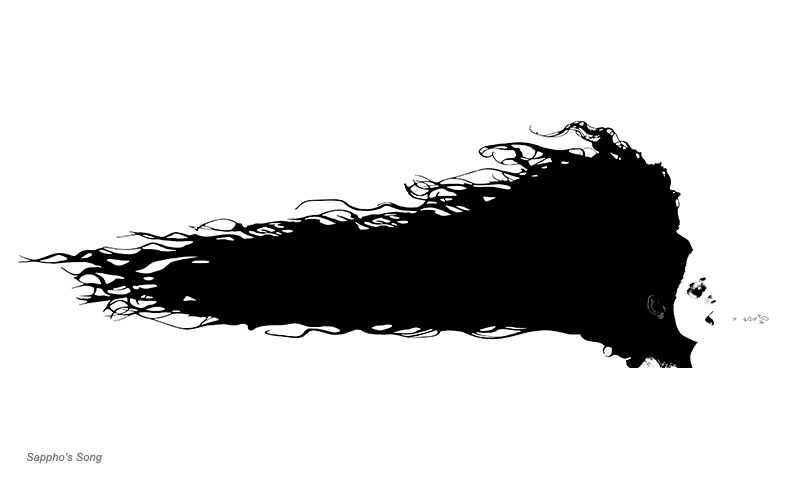
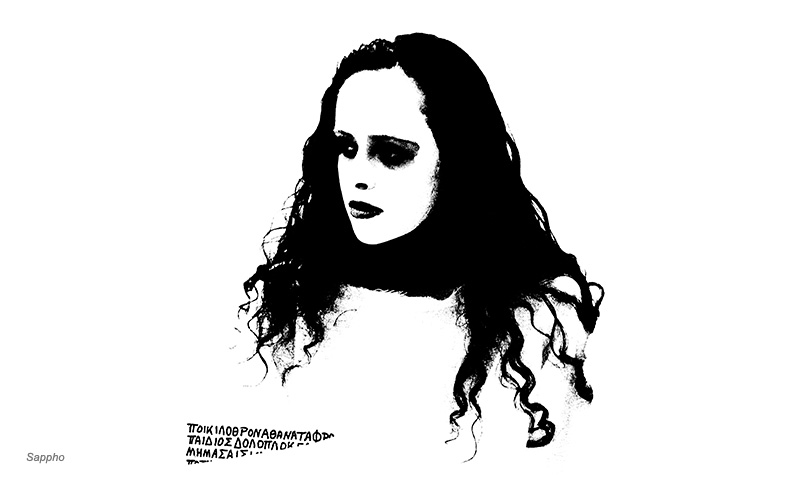
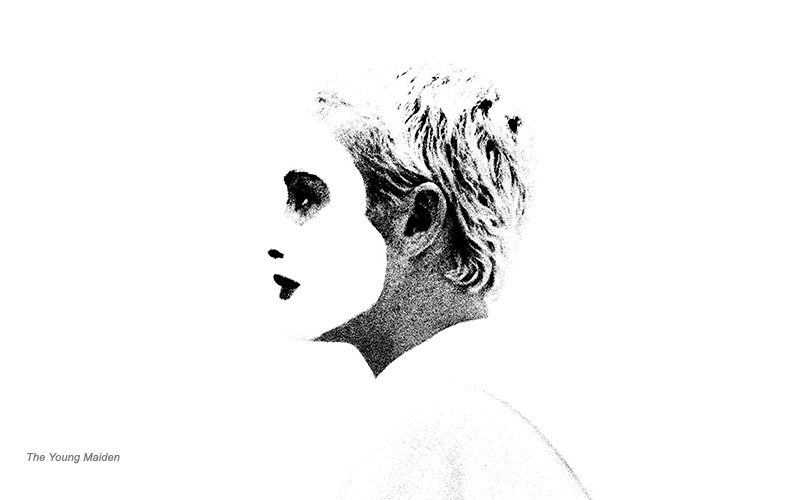
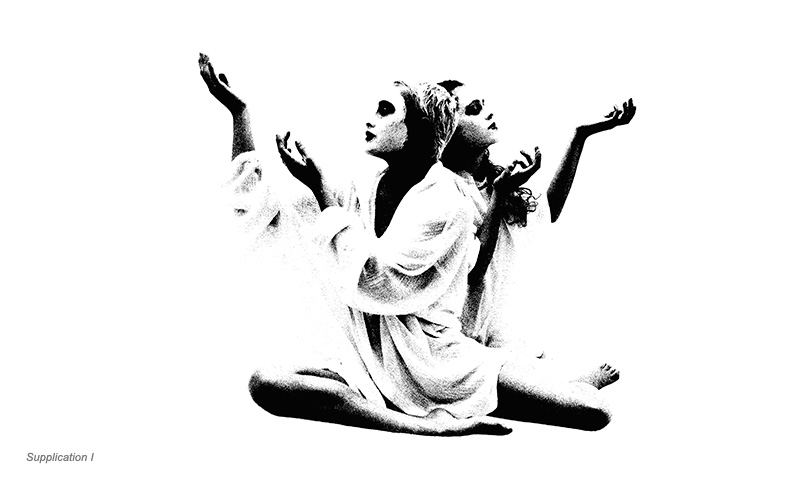
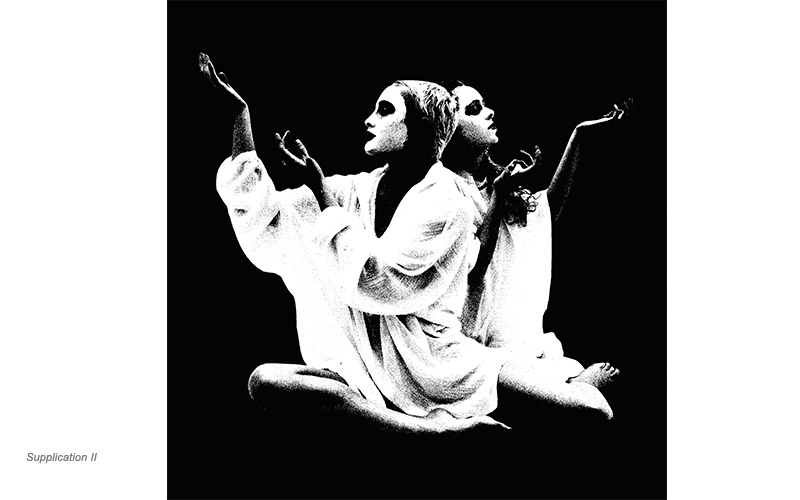
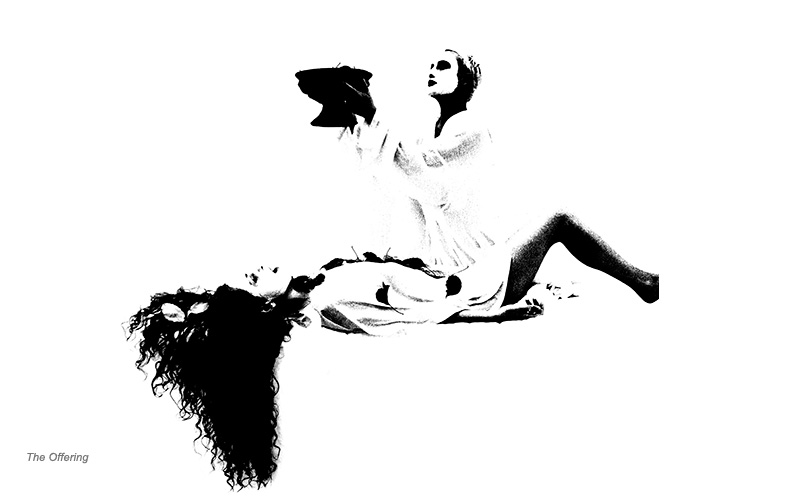
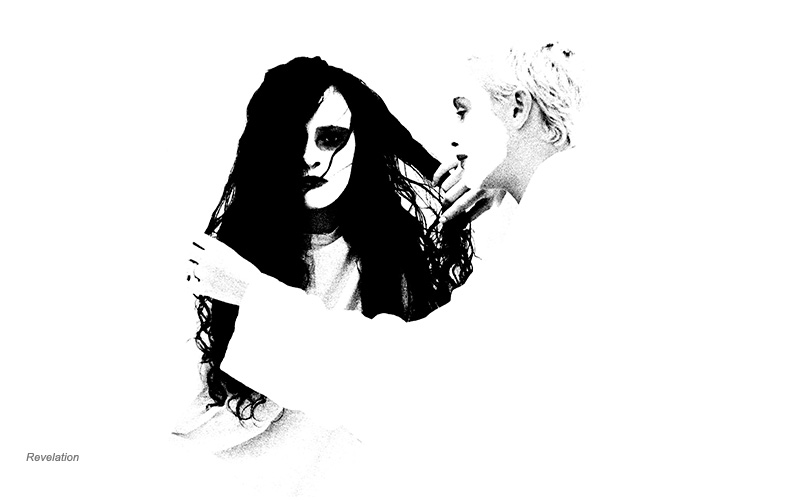
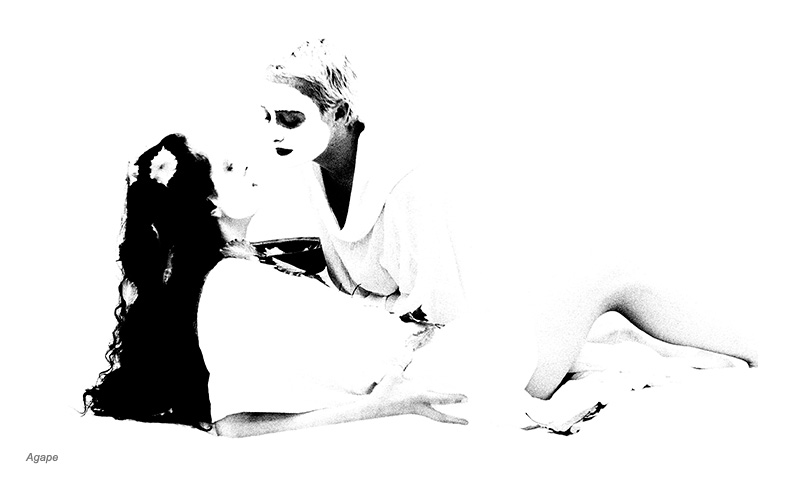


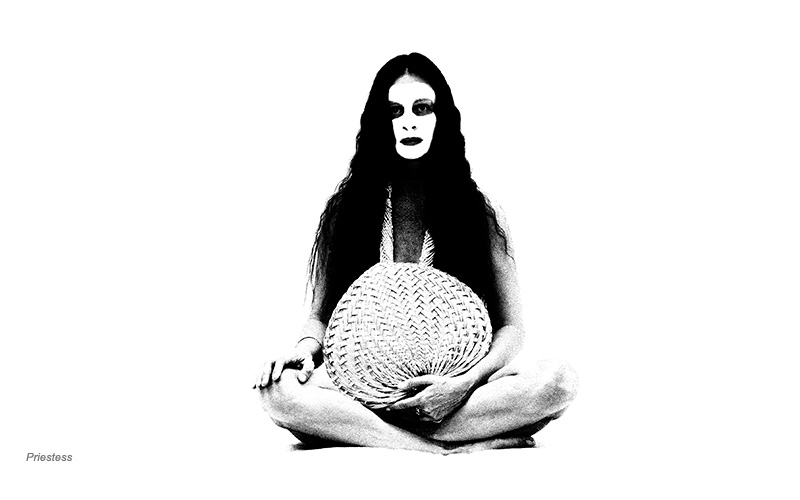
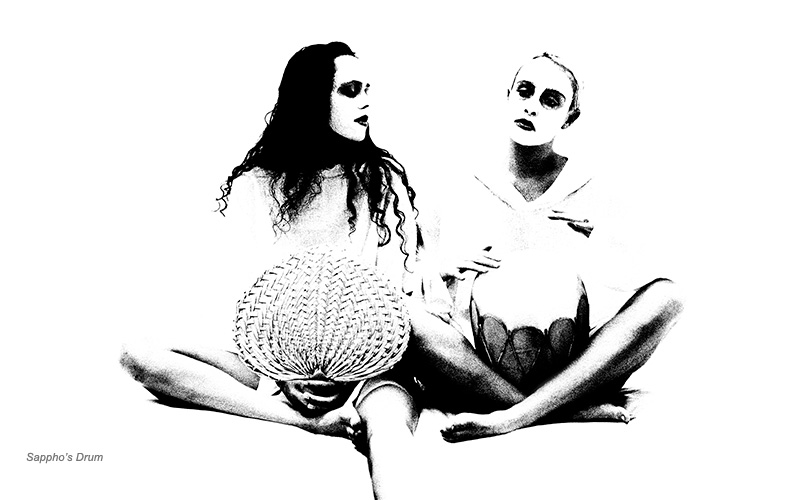
The Sapphographs
Sappho’s Song
pigment print on watercolor paper
50.5 in. x 144 in.
Sappho
pigment print on watercolor paper
60 in. x 60 in.
The Young Maiden
pigment print on watercolor paper
60 in. x 60 in.
Supplication I
pigment print on watercolor paper
60 in. x 60 in.
Supplication II
pigment print on watercolor paper
60 in. x 60 in.
The Offering
pigment print on watercolor paper
60 in. x 60 in.
Revelation
pigment print on watercolor paper
60 in. x 60 in.
Agape
pigment print on watercolor paper
60 in. x 60 in.
Delta
pigment print on watercolor paper
51.5 in. x 96 in.
The Youth … who fondly sits by thee
pigment print on watercolor paper
60 in. x 60 in.
Priestess
pigment print on watercolor paper
60 in. x 60 in.
Sappho’s Drum
pigment print on watercolor paper
60 in. x 80 in.
The Tenth Muse
The Tenth Muse is a three dimensional multi-media installation based on Donovan’s Sapphographs, created by Revolver, the California based art installation team. Revolver partners Braxton Carter and Christiann Moore refer to The Tenth Muse as a piece of ‘technology art’. Carter and Moore formed a creative partnership in 1995, fueled by an interest in the ability to create art in the third dimension. By using the mouse and the keyboard, the spectator can interact with Donovan’s three dimensional Sapphographs by rotating, expanding, closing in, or moving the image forward or backward. The spectators decide whether they want to see one image or five images at a time. Donovan’s Sapphographs will pulsate around the spectator’s point of view as if they were standing inside the Sapphograph. The beauty of the tenth muse is intuitive, hypnotic, and visually stimulating. Revolver created The Tenth Muse to celebrate Donovan’s exhibition of Sapphographs at the Hellenic American Union in Athens.
-------
This video is a sample of a viewer in front of a computer interacting with The Tenth Muse.
Revolver
The Tenth Muse
2010
Multi-Media Installation
Two 52” Sony HDTV Monitors
Two Sony VAIO Laptops
Revolver 3D Active Viewing Software
Courtesy Govinda Gallery, Washington, D.C.
This installation is supported by Sony Hellas.
Video set to Donovan's song "Be Mine" off his 1996 album Sutras.
Donovan
Donovan is a prolific songwriter, poet and musician who is recognized as one of the most popular and innovative recording artists of our time. By incorporating elements of folk, jazz, classical, Caribbean and Indian music, he became one of the central figures in the extraordinary musical and cultural revolution of the 1960s. He continues to influence and inspire musical artists today. Donovan’s recordings have received universal critical acclaim and he continues to perform throughout the world. Donovan was awarded an Honorary Doctor of Letters from the University of Hertfordshire in 2003. His autobiography, Donovan: The Hurdy Gurdy Man was published in 2005. Donovan was named the BMI Icon of 2009, acknowledging him as “a unique and indelible influence on generations of music makers”. In 2009 Donovan received the American Visionary Art Museum’s prestigious Grand Visionary Award.
Chris Murray
Chris Murray is the founder and director of Govinda Gallery in Washington, D.C. Since 1975, Murray has organized over 200 exhibitions of many of the leading artists of our time, including Andy Warhol in the 1970s and Annie Leibovitz’s first exhibition in 1984. Since that time, Murray has established Govinda as one of the most innovative contemporary galleries in the United States. Murray has been the author or editor of over a dozen books and catalogs including Elvis 1956 (Welcome Books, 2009), Soul Rebel: An Intimate Portrait of Bob Marley (Insight Editions, 2009), and John and Yoko: a New York Love Story (Insight Editions, 2008). Most recently Murray has curated Elvis at 21 a Smithsonian Institution travelling exhibition that is currently touring museums throughout America.
Gregory Nagy
Gregory Nagy is the Francis Jones Professor of Classical Greek Literature and Professor of Comparative Literature at Harvard University. He is also the curator of the university’s Milman Parry Collection of Oral Literature. His special research interests are archaic Greek literature and oral poetic. He is the author of The Best of the Achaeans. Currently, he serves as Director of Harvard’s Center for Hellenic Studies in Washington, D.C., while teaching half time at Harvard’s Cambridge campus. In 2006, he accepted the Onassis Award on behalf of the Center of Hellenic Studies.
Hellenic American Union
Founded in 1957, the Hellenic American Union is a public-service institution with an international focus and strong community commitment, dedicated to providing opportunities for a diverse range of audiences to encounter and benefit from innovative educational programs and cultural events. The institution is a not-for-profit association with historic ties to the United States and program links to Western European, American, and Balkan institutions but is wholly autonomous and self-financing.
The Hellenic American Union has been one of the most prominent institutions on the Athens cultural scene and a forum where members of the public can encounter new trends in art, science, and technology from Europe and the United States. Through a rich program of exhibitions, performances, concerts, lectures and seminars the institution promotes the exchange of ideas on art, science, and society.
Center for Hellenic Studies
Harvard University’s Center for Hellenic Studies, located in Washington, DC, is a research and educational institution dedicated to promoting understanding of Hellenic civilization in the widest sense. This vision sees Greek language and culture as the central point of contact for all the civilizations of the ancient Mediterranean world. The Center houses one of the world’s premier research libraries and elects resident Fellows from around the world to pursue work there. CHS also publishes books both electronically and through Harvard University Press, hosts a wide range of conferences, lectures, and teaching programs, and supports many outreach projects. The Director of the Center is Gregory Nagy, concurrently the Francis Jones Professor of Greek Literature teaching at the Harvard campus in Cambridge.
Govinda Gallery
Established in 1975, Govinda Gallery has organized numerous exhibitions both at its Washington, D.C. gallery, as well as in museums and galleries throughout the United States and abroad. Among these exhibitions are The Lost Amazon: The Photographic Journey of Richard Evans Schultes, National Museum of Natural History, Smithsonian Institution, 2008, Bob Dylan: The Photographs of Dan Kramer, Stax Museum of American Soul Music, Memphis, TN, 2005, and Artist to Icon, the inaugural exhibition for the Experience Music Project in Seattle, 2001. Govinda’s exhibitions have received critical accolades in Vanity Fair, Rolling Stone, The Washington Post, USA Today, The International Herald Tribune, American Photo, and GQ to name a few.
From 1986 to 2006, Govinda Gallery was the exclusive distributor in the United States for Genesis Publications of England, publishers of fine limited edition, autographed books. Since 2002, Govinda Gallery has produced numerous books and catalogues in collaboration with the many of the artists exhibited at the gallery.
Acknowledgements
To Donovan, from whom I have learned so much about Sappho, poetry, and ancient Greece. To Linda, Donovan’s wife and muse, who collaborated with Donovan creating the costumes, make up and set for his Sapphographs.
This exhibition is the result of the hard work and imagination of a committed team. I am greatly indebted to Greg Nagy at the Center for Hellenic Studies for his vision and enthusiasm. I want to express my deep appreciation to Robin Olson and Zoie Lafis, also at the Center for Hellenic Studies, for coordinating all of our efforts so nicely. Thank you to Ira Papadopoulou at the Hellenic American Union in Athens for her expert assistance with every detail of the exhibition.
The Sapphographs in this exhibition were produced at Atelier Adamson in Washington, D.C. Thank you to David Adamson, John Hughs, Wade Hornug, and Colin Loughlin at Atelier Adamson. I remain, as always, in awe of their dedication to excellence. I want to acknowledge my staff at Govinda Gallery who assisted me in my work curating this exhibition… To David Murray, Govinda Gallery manager, Emma Denvir, touring exhibitions assistant, Cat Henry, blog editor and curatorial assistant, and Vivienne Foster, registrar.
I owe an immense debt of gratitude to Cary Scott who designed this online publication and who is also Govinda Gallery’s web designer. My appreciation to Olvia Demetriou for her advise and enthusiasm in bringing Donovan’s Sapphographs to Greece. Thank you to Savina Donohoe, Catriona O’Reilly, and Martin Donohoe for their support of Donovan’s Sapphographs. And to my wife Carlotta for all of her love along the way.
– Chris Murray
Colophon
Published on the occasion of the exhibition Sapphographs by Donovan.
Developed collaboratively by the Hellenic American Union, Athens, Center for Hellenic Studies, Washington, D.C., and Govinda Gallery, Washington D.C.
Hellenic American Union
Massalias 22
Athens 10680
Greece
June 1 – June 30, 2010
Published by
Govinda Gallery, Washington D.C.
202-333-1180
Editor: Christopher Murray
Design: Cary Scott
Sapphographs © Donovan 2010
Introduction © Christopher Murray 2010
Foreword © Gregory Nagy 2010
Preface © Donovan 2010
The Tenth Muse © Revolver 2010
All rights reserved. No part of this book may be reproduced or utilized in any form or by any means, electronic or mechanical, including photocopying, recording, or by any information storage or retrieval system, without permission in righting from the publisher.
Donovan’s Sapphographs are available through Govinda Gallery.
Revolver is represented by Govinda Gallery.
Sapphographs by Donovan | Copyright © 2010 | A Govinda Gallery Publication | Website Design by Cary Scott